Abstract
Archaeological mollusk shells, such as those of Littorina obtusata/fabalis, hold valuable information about past human behavior and cultural practices. However, the original coloration of these shells, crucial for understanding their symbolic significance, is often lost due to taphonomic processes. Raman spectroscopy is a powerful technique for non-destructive analysis of archaeological samples, enabling the identification of pigments and mineralogical components. In this study, we present a methodology to predict, using Raman spectroscopy and k-means clustering, the original coloration of archaeological L. obtusata/fabalis shells which have lost their original coloration. Raman spectra were acquired from both modern shells, exhibiting a range of natural colors, and archaeological shell samples from La Chora cave (Cantabria, northern Spain). Spectral data were preprocessed to remove noise and baseline effects, and k-means clustering was applied to group the spectra based on their inherent spectral similarities. By comparing the spectral signatures of the archaeological samples with those of the modern shells within the generated clusters, we inferred the likely original coloration of the archaeological specimens. This approach provides a quantitative framework for predicting archaeological shell colors.
1. Introduction
The study of archaeological materials provides deeper understanding of the symbolic behaviors and cultural practices of past societies. Coloration in prehistoric artifacts and ornaments, including mollusk shell artifacts, is not merely decorative; it carried symbolic meaning and served social or ritual functions. Moreover, such objects can act as identity markers distinguishing different groups of hunter-gatherers, offering insights into cultural connections and interaction networks between distant groups [1,2,3,4,5]. Prehistoric mollusk shells were valued not only for their utilitarian functions but also for their aesthetic and symbolic significance in ancient societies. The original coloration of these shells, derived from a variety of pigments, likely played a role in ceremonial contexts, social status, and personal ornaments. Some studies [6] suggest that the patterns and distribution of pigments offer critical insights into the cultural practices and symbolic expressions of prehistoric populations. Specifically, L. obtusata shells were systematically used for personal ornamentation by the hunter-gatherer groups that occupied the Cantabrian region from the beginning of the Upper Paleolithic to the Mesolithic [7]. Mollusk shells exhibit a wide range of pigmentation patterns due to the presence of biomolecules such as polyenes, porphyrins, and melanins [8,9,10,11], with the pigments embedded within or between the mineralized layers of the shell. The shell itself is primarily composed of calcium carbonate (CaCO3), in the form of aragonite or calcite polymorphs, along with an outer periostracum, a thin organic layer mainly composed of conchiolin proteins.
Raman spectroscopy (RS) is a non-destructive spectroscopic technique that provides detailed information about the molecular composition and structure of a sample by analyzing the interaction of light with molecular vibrations. This technique offers several advantages, notably its non-destructive nature and the minimal sample preparation required. Unlike some analytical methods that necessitate dissolving or altering the sample, RS allows for in situ analysis, preserving the integrity of the specimen, which is particularly crucial when studying archaeological samples [12]. The ability to analyze these samples with minimal intervention ensures that they can be studied repeatedly and preserved for future research. Furthermore, the limited need for sample preparation simplifies the analytical process, making it more efficient and reducing the risk of contamination or damage to the sample. These advantages make RS an invaluable tool for investigating pigments and other materials in archaeological samples.
The Raman spectrum of carotenoids has been widely studied [8,9,13,14]. These investigations have established the characteristic Raman vibrational modes for carotenoids, particularly the prominent peaks associated with the C-C single bond (around 1150 cm−1) and C=C double bond (around 1520 cm−1) stretching vibrations, which act as key spectral fingerprints. Furthermore, RS has been successfully applied to identify these pigment molecules in situ within complex biomineralized matrices, including both recent and fossil mollusk and brachiopod shells. Such studies demonstrate the utility of RS in linking specific spectral signatures to the chemical basis of coloration in these biological materials.
While RS provides detailed spectral data, the complexity and volume of these datasets needs analytical approaches for meaningful interpretation. Clustering algorithms (CAs), such as k-means or agglomerative hierarchical clustering (AHC), alongside dimensionality reduction methods like principal component analysis (PCA) [15], offer an effective means of classifying Raman spectra based on spectral similarities [16,17], enabling the identification of distinct pigment populations within the shell [18]. These unsupervised ML techniques allow for unbiased classification of Raman spectra, facilitating the detection of underlying pigment variations and providing a more objective assessment of pigment distribution. Combining RS with CAs like k-means enables the spatial mapping of pigment heterogeneity, revealing potential differences in composition, concentration, and degradation patterns across the shell structure.
The taxa Littorina obtusata (Linnaeus, 1758) and Littorina fabalis (W. Turton, 1825) are morphologically indistinguishable from each other except for the anatomy of their reproductive organs and their genetic variation [19,20,21,22,23]. Some expert taxonomists may be able to distinguish the two species in isolated populations, but their criteria do not hold when changing geographic regions. Therefore, only reproductive and molecular variation is reliable for establishing their distinction [19]. For this reason, we refer to the analyzed samples as Littorina obtusata/fabalis, given the impossibility of accurately determining whether they belong to one taxon or another.
L. obtusata/fabalis shells range in color from bright yellow to reddish brown and almost black and include all shades of orange and green [6,24]. However, archaeological samples of some ornamental mollusk shells exhibit heavily faded colors or a white coloration not observed in living specimens. The preservation of coloration is primarily governed by the chemical composition and stability of the pigments responsible for surface coloration, as well as the shell’s mineralogical composition [25]. The degradation or loss of color is influenced by a range of taphonomic agents. Among these, abrasion, corrosion, and thermal alteration constitute the principal taphonomic processes associated with the deterioration of the original shell coloration, and they can exert a substantial impact on surface pigment retention [26]. These processes can alter or even remove pigments over time. However, it is our hypothesis that traces of pigments still remain, and by means of RS, the original color of the shells can be predicted. This ability to recover information about the original color is fundamental for fully understanding the cultural and symbolic value of these artifacts. In this work, we propose a methodology to predict the color of archaeological L. obtusata/fabalis shells using RS and k-means algorithm. By analyzing polished cross-sections, we also seek to identify pigment-related spectral features and assess pigment distribution across different shell layers to provide a comprehensive understanding of shell coloration. The findings of this study offer a quantitative and systematic framework for archaeological shell color prediction, with potential applications for future research on archaeological, fossilized, and modern mollusk shells. Furthermore, this methodology can be applied to investigate pigment preservation in other biomineralized structures.
2. Materials and Methods
2.1. Sample Collection
For this study, two distinct sets of L. obtusata/fabalis shells were analyzed for different experimental objectives.
The first set was used for a validation analysis of internal pigment distribution via cross-sectioning. For the analysis of pigment distribution in the shell, four polished cross-sections of L. obtusata/fabalis shells were examined. These specimens were collected from the Galician region, specifically Balleneras Beach (Vigo, northern Spain), in April 2024. The sample set included two shells collected alive and two collected post mortem (Postmortem 1, Postmortem 2, Alive 4, and Alive 5). To ensure optimal conditions for spectroscopic analysis of the pigment distribution, all specimens were thoroughly cleaned, sectioned, and polished to achieve smooth surfaces that minimize irregularities and enhance spectral acquisition.
The second set, which forms the core of this study for non-destructive color prediction, incorporates a collection of modern and archaeological L. obtusata/fabalis shells, which exhibit varied color tones. Among these are two Mesolithic shells (labeled LIT235.3 and LIT885.1) which are associated with a human occupation in La Chora cave (Voto, Cantabria, northern Spain) and dating between 8170 and 7800 cal BP [27]. The two archaeological samples lack the distinct coloration observed in the modern ones, presenting a whitish and dull appearance. The second collection is shown in Figure 1.
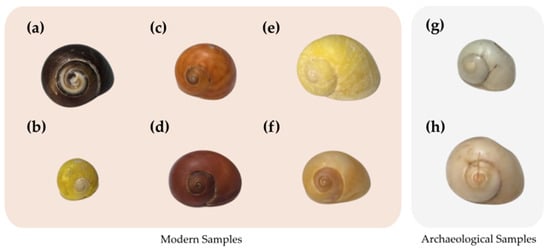
Figure 1.
Collection of L. obtusata/fabalis shells consisting of six modern specimens exhibiting different colors: (a) LIT1; (b) LIT2; (c) LIT3; (d) LIT4; (e) LIT5; (f) LIT6, alongside two archaeological samples, (g) LIT235.3 and (h) LIT885.1.
The shells of L. obtusata/fabalis are primarily composed of aragonite, which constitutes most of their mineralized structure. The shell itself includes an outer periostracum, followed by prismatic and crossed-lamellar layers formed by densely packed aragonite crystals. The pigments responsible for shell coloration of this species (from yellowish to dark reddish-brown tones) are embedded within or between these mineralized layers.
2.2. Sectioning, Polishing Procedure and Raman Spectra Acquisition for Cross-Sectional Analysis
Each shell was carefully attached to the outer edge of a 5 cm × 1 cm acrylic block using a two-part epoxy adhesive (Araldite) consisting of a resin and a hardener. This strong bonding method ensured stability throughout the cutting and polishing process, preventing displacement or damage during sample preparation. Once the epoxy had fully cured, each specimen was sectioned using a Buehler Isomet 1000 precision cutter.
Following sectioning, shell surfaces were polished using an automatic lapping and polishing unit (Kent 3) to achieve a uniform and reflective surface. The polishing process was conducted in sequential steps to ensure optimal sample preparation for RS:
- Rough-polished with 400-grit silicon carbide paper (3 min) to remove major irregularities.
- Intermediate polishing with 800-grit paper (5 min) and then 1200-grit (5 min) paper to refine and smooth the surface.
- Fine polishing with 2000-grit waterproof abrasive paper (5 min).
- Final lapping using 12 μm lapping film (5 min) to achieve a mirror-like finish.
The polished cross-sections were then cleaned with ultrapure water and ethanol to remove polishing residues and stored in a controlled dry environment before RS analysis.
2.3. Raman Spectra Acquisition
For this study, Raman spectra acquisition was performed using two distinct instrumental setups, each used for a specific analytical objective. The first method focused on the detailed analysis of pigment distribution in cross-sections of the shells, while the second was used for mapping the surface of the shells from the collection shown in Figure 1 in order to obtain spectra for clustering analysis and color prediction. Regarding the first method, for analyzing pigment distribution in cross-sections, Raman measurements were performed using a confocal RS microscope (XperRAM C-Series, NANOBASE, Seoul, South Korea), equipped with a 532 nm laser and a 20× objective lens (MPlanFL, Olympus, Tokyo, Japan, NA 0.75), allowing for high-resolution spectral acquisition. Spatial Raman mapping was conducted to analyze pigment distribution across the shell section. The mapping was performed with a step size of 5 μm in both the X and Y axes. This high-resolution approach resulted in the acquisition of approximately 3200–3400 spectra per cross-section. At each point, spectra were averaged from two individual measurements, with each measurement lasting 1.5 s and using a laser power of 2 mW.
For the surface mapping of the L. obtusata/fabalis shell collection (shown in Figure 1), spatial Raman mapping was performed using a custom setup equipped with a 532 nm RGB Lasersystem Lambda laser, an Inphotonics Raman probe, and a QEPRO Ocean Optics spectrometer (RGB Lasersystems, Ballószög, Hungary). The data acquisition was controlled by a custom software interface developed in MATLAB (version 2023b). Spatial maps were performed with a step size of 0.1 mm between points. The dimensions of these maps were adjusted for each shell, leading to an average of approximately 6500 spectra per sample. It is important to note that for the archaeological specimens, this number was typically lower (around 3800 spectra), as measurements affected by significant sample-induced fluorescence were discarded during preprocessing to ensure data quality. At each point, the final spectrum was obtained by averaging two acquisitions, each measurement with an integration time of 1 s, using a laser power of 25 mW.
2.4. Spectral Data Analysis and Analysis Algorithms
2.4.1. Spectral Preprocessing
Preprocessing the raw Raman spectra is essential to enhance data quality prior to clustering analysis [15]. This procedure aimed to minimize systematic variations caused by experimental noise and fluorescence. The preprocessing pipeline, shown in Figure 2, involved the following sequential steps:
- Background subtraction: the instrumental background noise, measured independently, was subtracted from each raw spectrum acquired by the spectrometer.
- Spectral range selection: spectra outside this biological window were removed to focus the analysis and reduce computational load.
- Baseline estimation: the baseline was estimated using the Whittaker–Henderson smoothing method, commonly referred to as asymmetric least squares (ALS) [28].
- Baseline correction: the estimated baseline was subtracted from the cut spectrum. This step yielded the final corrected spectrum, where the broad background trend was removed, allowing the characteristic Raman peaks to be more clearly distinguished.
Subsequently, a final preprocessing stage involved standardizing each spectrum. This process accounts for variations in overall spectral intensity between different measurements, which can arise from factors unrelated to chemical composition, such as minor differences in laser focus, sample positioning, or residual fluorescence, ensuring that spectra are comparable primarily based on their shape and relative peak intensities before applying any analysis algorithm.
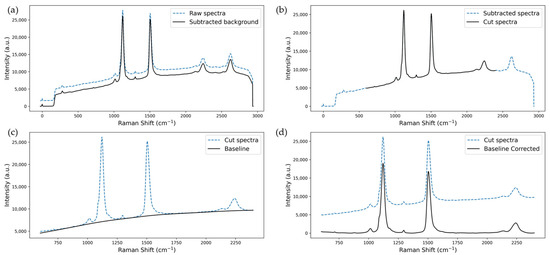
Figure 2.
Sequential steps for preprocessing a representative Raman spectrum. (a) The measured instrumental background is subtracted from the raw spectrum; (b) the spectral range is limited to the region containing relevant peaks (biological window); (c) a baseline is estimated for the selected range using Asymmetric Least Squares; (d) the estimated baseline is subtracted to yield the baseline-corrected spectrum used for analysis.
2.4.2. Analysis Algorithms
Unsupervised clustering algorithm was employed to analyze the Raman spectral data obtained from mollusk shells. The primary objective of applying these techniques was to group spectra based on their similarities, aiming to create a basis for inferring the potential original coloration of archaeological samples where visible color has degraded over time. Distinct clusters, representing groups of spectra with similar chemical or molecular signatures captured by RS, may correlate with the original pigments present in the shells. By clustering the modern samples and the archaeological samples, we aim to assign the archaeological spectra to clusters associated with specific color characteristics, thereby predicting their likely original appearance.
One specific algorithm employed for this purpose was k-means, an iterative partitioning method well-suited for identifying distinct groupings by minimizing the Euclidean distance between spectra and their assigned cluster centroid. A key requirement of the k-means algorithm, however, is that the number of clusters (K) must be specified beforehand. Determining the optimal number of clusters is therefore needed. Techniques like the elbow method are often evaluated to guide this selection by analyzing clustering performance metrics across different K values. This approach provides a visual way to evaluate the optimal number of clusters by examining the differences in the sum of squared errors (SSE) for each cluster. The point where the decrease in SSE is most pronounced, the “elbow”, indicates the best K values [29]. In this study, the elbow method was evaluated by testing K values in a range from 1 to 15, and K = 5 was selected based on identifying the point of inflection. The plot corresponding to this analysis is provided in the Supplementary Materials (Figure S1).
To quantitatively evaluate the similarity between the archaeological samples and the modern reference samples after applying the k-means algorithm, the Pearson correlation coefficient (r) is used [17]. This coefficient is a statistical measure indicating the strength and direction of a linear relationship between two variables. A high positive correlation (r close to +1) between the distribution of an archaeological sample and of a modern sample indicates that both tend to group similarly according to the partition generated by k-means, suggesting a spectral resemblance that can be used to infer the potential original coloration of the archaeological sample.
Figure 3 illustrates the analysis workflow, including data acquisition, preprocessing, optimal cluster number determination (K) using the elbow method, and the application of k-means clustering.

Figure 3.
Raman data analysis workflow using k-means clustering, including data acquisition, preprocessing, optimal cluster number determination (K), and clustering application for spectral grouping.
3. Results
3.1. Surface Preparation and Polishing
The quality of the shell surface plays an important role in confocal RS, as irregularities or surface defects can scatter laser light and introduce spectral noise. Figure 4 presents a comparative view of the polished surfaces of the sample Postmortem 2. Each subfigure highlights distinct improvements in smoothness and reflectivity achieved through the sequential application of different filters:
- Figure 4a: unpolished surface immediately after cutting. The surface is rough, with visible irregularities and microfractures.
- Figure 4b: rough polishing with 400-grit silicon carbide paper (3 min) removes major surface irregularities.
- Figure 4c: intermediate polishing with 800-grit paper (5 min) significantly reduces surface roughness.
- Figure 4d: additional polishing with 1200-grit paper (5 min) for further refinement.
- Figure 4e: fine polishing with 2000-grit waterproof abrasive paper (5 min) enhances reflectivity.
- Figure 4f: final lapping using 12 μm lapping film (5 min) achieves a highly reflective surface, contributing to a uniform focal depth.
A polished surface is important for confocal RS, where an optically smooth finish allows for consistent laser coupling and minimizes scattering artifacts. However, achieving an exact mirror-like finish may not be strictly necessary. The key requirement is to obtain a surface where the irregularities do not prevent the establishment of a uniform focal plane across the area of analysis. Indeed, surface irregularities that cause significant variations in focal depths will complicate the detection of subtle pigment Raman peaks.
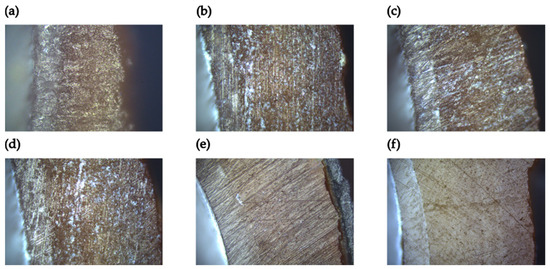
Figure 4.
Images of the L. obtusata/fabalis (Postmortem 2) shell cross-section at successive polishing stages: (a) unpolished; (b) 400-grit; (c) 800-grit; (d) 1200-grit; (e) 2000-grit; (f) 12 μm film.
3.2. Raman Spectra Analysis
Initial analysis of the acquired Raman spectra focused on identifying the principal chemical components of the L. obtusata/fabalis shells. The dominant spectral features consistently matched those of aragonite, CaCO3, which constitutes the primary mineral phase of these shells. The most intense characteristic Raman band observed was the symmetric stretching vibration (ν1) of the carbonate group, appearing around 1085 cm−1; this peak is common to all major CaCO3 phases, including aragonite and calcite [8,30]. Other characteristic peaks of the aragonite lattice structure (around 150 cm−1, 208 cm−1, and 710 cm−1) further confirmed its identity. Polyenes, specifically carotenoids, are the primary pigments responsible for coloration in these shells. Correspondingly, the spectra frequently exhibited Raman bands of carotenoids. The most significant of these were the strong peaks associated with C-C single-bond stretching (ν2) around 1150 cm−1 and C=C double-bond stretching (ν1) around 1520 cm−1 [8,9,13,14]. The signals above 2000 cm−1 represent overtone and combination bands (mainly of the intense ν1 and ν2 bands) [12]. Figure 5 shows a representative Raman spectrum obtained from a shell sample, clearly highlighting these principal vibrational bands attributed to both the aragonite matrix and the embedded carotenoid.

Figure 5.
Average Raman spectrum of a flat periwinkle shell (LIT6), along with calcite, aragonite, and carotenoid lines.
While Figure 5 illustrates the main Raman spectral components of a mollusk shell, significant variation exists between individual shells, particularly in the relative intensities of the carotenoid bands compared to the aragonite/calcite matrix signals. This variability is crucial for distinguishing between samples with different pigment levels or preservation states. To visualize these inter-sample differences directly, Figure 6 presents the baseline-corrected average Raman spectrum for each individual sample analyzed in this study. This includes the modern reference samples (LIT1-LIT6) and the two Mesolithic archaeological samples (LIT235.3 and LIT885.1).
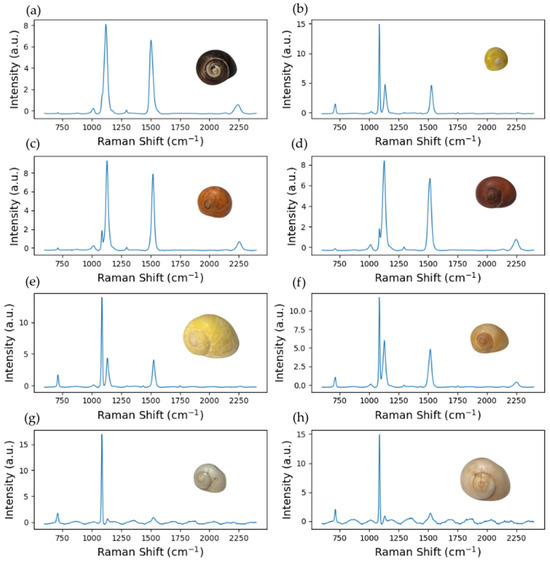
Figure 6.
Average Raman spectrum from the L. obtusata/fabalis collection: (a) LIT1; (b) LIT2; (c) LIT3; (d) LIT4; (e) LIT5; (f) LIT6; (g) LIT235.3; (h) LIT885.1.
As seen in Figure 6g,h, the archaeological samples (LIT235.3 and LIT885.1) show significantly reduced carotenoid peak intensities compared to the colored modern shells, which is consistent with their visually faded appearance and the hypothesis of taphonomic degradation.
3.3. Pigment Distribution in Polished Shell Sections
Raman mapping on the polished cross-sections allowed us to investigate the spatial distribution of chemical components within the shell structure. Figure 7 shows the layout of the spectral measurement points across the polished cross-section of an L. obtusata/fabalis shell using the confocal Raman system mentioned in Section 2.2.
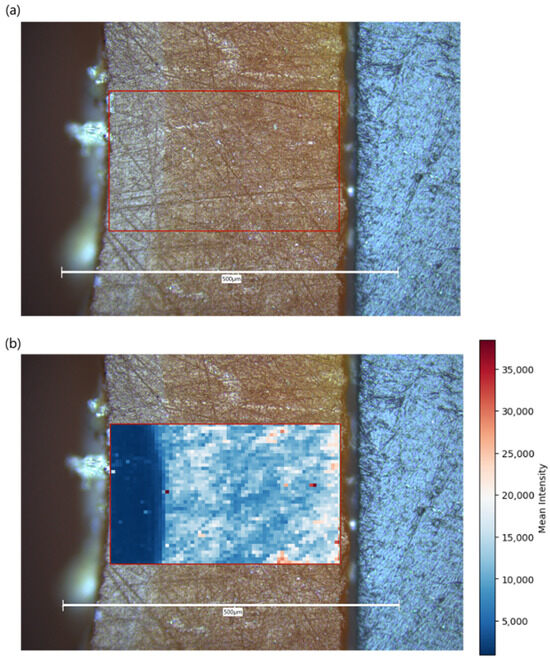
Figure 7.
Pigment distribution analysis on the polished cross-section of an L. obtusata/fabalis shell (sample “Alive 5”). (a) Optical image of the shell’s cross-section, showing the rectangular area selected for Raman mapping; (b) Raman spectral intensity map corresponding to the carotenoid peaks (1150 cm−1 and 1520 cm−1) across the mapped area, where the color bar indicates the mean intensity of these peaks.
To visualize this spatial heterogeneity, a heatmap was generated representing the intensity of the carotenoid peaks across the section (1150 cm−1 and 1520 cm−1 peaks). Figure 7b displays this heatmap for the analyzed L. obtusata/fabalis shell cross-section (Sample Alive 5), where the color intensity at each point indicated by the color bar corresponds to the measured mean carotenoid Raman intensity corresponding to the relative abundance of carotenoids measured at that point.
Examining the heatmap in Figure 7b reveals the spatial pattern of carotenoid distribution within the shell cross-section. The left side of the heatmap (corresponding to the inner part of the shell) shows predominantly low carotenoid intensity (deep blue band). Moving towards the right side of the mapped area, to the more external layer of the shell, the carotenoid intensity varies significantly. Instead of a single concentrated band at the edge, the heatmap shows a heterogeneous distribution of carotenoids. Regions of higher carotenoid intensity (reddish and white spots) are present, appearing as scattered spots and patches distributed across the area to the right. This heterogeneous distribution demonstrates that carotenoid pigments are not uniformly spread throughout the shell layers shown in the cross-section. This confirms the presence of detectable carotenoid pigment signals distributed within the polished surface representing the internal layers of the shell, rather than being confined in the periostracum.
3.4. Clustering Analysis of Raman Spectra
The k-means algorithm was applied to a collection of Raman spectra obtained from the surface of modern and archaeological samples using the custom setup explained in Section 2.3. The optimal number of clusters for k-means analysis was determined as K = 5 using the elbow method as described in Section 2.4.2.
The five clusters identified by the k-means algorithm represent distinct spectral profiles present within the data. Figure 8 shows the centroid spectra for each of the clusters. These centroid spectra are key to interpreting what molecular features define each group. The distribution of spectra from each individual sample provides a “signature” of its overall spectral composition. The spectral differences that distinguish the groups can be identified as the relative intensity of carotenoid bands (approximately 1150 cm−1 and 1520 cm−1) compared to aragonite bands (mainly 1085 cm−1).

Figure 8.
Centroid spectra of the five clusters identified by the k-means algorithm. Each spectrum represents the average spectral profile for all data points assigned to that specific cluster.
In carotenoid spectra, these two dominant bands are commonly referred to as the ν2 band (~1150 cm−1) and the ν1 band (~1520 cm−1). Specifically, the ν1 band is one of the most intense and corresponds to the C=C stretching vibration in the central part of the polyene chain. The ν2 band is assigned to a mixed vibration that includes C-C and C=C stretching, coupled with C-H in-plane bending. The relative intensity of these bands is, therefore, a direct indicator of the carotenoid’s concentration [31].
Figure 9 shows the percentage distribution of spectra from each sample across these five clusters. This figure visually illustrates the spectral composition of each shell sample based on the proportion of its individual Raman spectra assigned to each cluster. The two archaeological samples show the dominance of Cluster 4. LIT235.3 shows an almost exclusive assignment to Cluster 4 (100%), while LIT885.1 also consists mainly of this cluster (85%), with minor contributions from other clusters (Cluster 1 and Cluster 3).
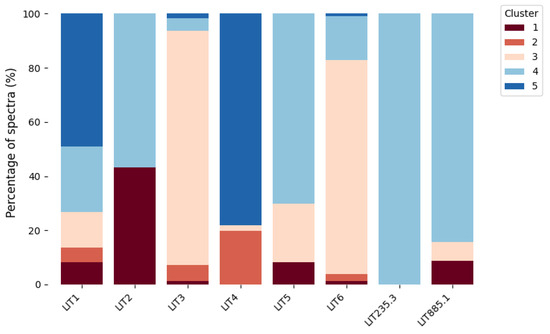
Figure 9.
Percentage distribution of Raman spectra across the five clusters for each L. obtusata/fabalis shell sample.
Comparing these archaeological distributions to the modern samples reveals a distinct pattern. The modern yellowish shells, LIT2 and LIT5, show distributions that are markedly similar to those of the archaeological samples. LIT5 is largely dominated by Cluster 4, although it also includes significant proportions from other clusters. Similarly, LIT2 shows a high percentage of Cluster 4, complemented by a substantial contribution from Cluster 1. This shared dominance of Cluster 4 visually differentiates them from other modern samples.
k-means followed by Pearson correlation analysis based on the cluster distribution of each sample was carried out as detailed in Figure 10. A strong positive correlation was consistently found between the archaeological samples and the modern yellowish shells. Specifically, high correlation coefficients were observed between both LIT235.3 and LIT885.1 compared to LIT5 and LIT2. This indicates that the archaeological shells grouped very similarly to these specific modern yellowish shells using k-means clustering. Given that LIT2 and LIT5 exhibit a yellowish coloration (Figure 1), this spectral similarity suggests that the archaeological shells share underlying chemical characteristics with these modern yellow samples.
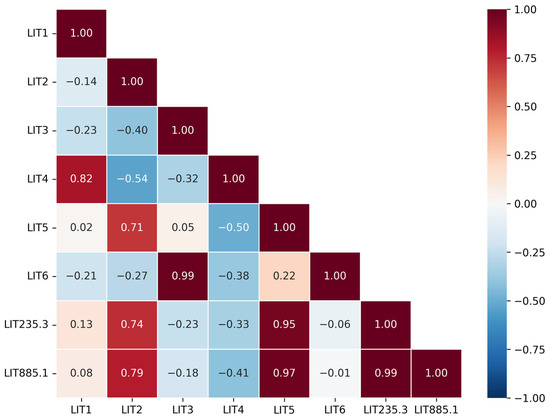
Figure 10.
Pearson correlation matrix between the cluster distribution vectors of the L. obtusata/fabalis samples. The heatmap shows the Pearson correlation coefficient (r) for each pairwise comparison of samples based on the percentage distribution of their spectra across the clusters.
4. Discussion
This study demonstrates the viability of combining RS with an unsupervised clustering technique to investigate the composition of pigments in mollusk shells, including archaeological specimens that have undergone visual degradation. The identification of characteristic Raman bands for both aragonites, the main mineral component of L. obtusata/fabalis, and carotenoids, the pigments responsible for its natural coloration, validates RS as a suitable tool for this type of analysis [8,14].
The findings regarding pigment distribution within L. obtusata/fabalis shells are particularly relevant. The spatial mapping of carotenoid intensity on polished cross-sections (Figure 7) revealed that pigment distribution within the shell layers is not uniform. This heterogeneity is significant because it indicates that pigments are not solely confined to the outermost periostracum but are also embedded within the mineralized layers. This spatial analysis is crucial for understanding how pigments are incorporated during shell growth and assessing their potential for preservation in different parts of the shell structure, which has implications for taphonomic studies.
The application of k-means effectively grouped the diverse Raman spectra obtained from the shell surfaces into five distinct clusters, represented by the centroid spectra shown in Figure 8. These centroids act as average spectral representatives for each cluster, highlighting the key molecular differences, likely related to varying concentrations or states of carotenoids relative to the aragonite matrix. The distribution of these spectral clusters among the different shell samples (Figure 9) provided a quantitative spectral “signature” for each shell. This signature was instrumental in correlating the archaeological samples with modern, known-color shells, suggesting an original yellowish hue for the faded archaeological specimens.
This statistical correlation is chemically explained by the polyene chain length, which determines the shell’s color and influences the position of the main Raman peaks. As detailed in the Supplementary Materials (Figure S2), a direct analysis of these peak positions confirms that the residual pigments in the archaeological shells have the same short-chain spectral characteristics as the modern yellow shells, providing a strong link between the clustering result and the chemical degradation process.
However, this method has limitations. The effectiveness of k-means clustering depends on the appropriate choice of the number of clusters and can be sensitive to initialization. Other CAs that do not require pre-defined K could be explored, like AHC or DBSCAN. Moreover, k-means can struggle with very large datasets due to computational demands.
Given the considerable variability in shell coloration and patterning within a single species and biotope, it is pertinent to consider that certain of these traits were likely linked to the selection of specimens used for the manufacture of personal ornaments during prehistory. In this regard, the potential to reconstruct the original coloration of L. obtusata/fabalis shells recovered from archaeological sites is of particular interest, as this taxon was consistently employed as personal adornment throughout an extended chronological sequence, spanning from the early Upper Paleolithic to the end of the Mesolithic (approximately 40–5 ka cal BP), across a wide geographical expanse of the European Atlantic coast. Therefore, identifying the natural coloration these shells exhibited when they were collected, perforated, and utilized as personal ornaments would offer valuable insights into whether prehistoric hunter-gatherer groups selected them based on their external characteristics—thus possibly driven by aesthetic, symbolic, or identity-related factors—and thereby contribute to a more nuanced understanding of their social significance.
5. Conclusions
This study demonstrated the effectiveness of combining RS with unsupervised CAs, specifically k-means, to classify spectral data from archaeological L. obtusata/fabalis shells. The analysis enabled the identification of pigment-related signals despite visual degradation and revealed non-uniform pigment distributions across shell layers. By correlating archaeological spectra with those of modern reference samples, the original coloration of the artifacts could be inferred, offering valuable insights into their cultural and symbolic significance. This approach provides a powerful tool for future conservation studies.
Supplementary Materials
The following supporting information can be downloaded at: https://www.mdpi.com/article/10.3390/chemosensors13070232/s1, Figure S1: Elbow Method plot showing the Within-Cluster Sum of Squares (WCSS) versus the number of clusters (K). The elbow at K = 5 indicates the optimal number of clusters for the analysis; Figure S2: 2D scatter plot showing the Raman shifts of the ν1 (C=C) and ν2 (C–C) polyene bands for all shell samples. Each point represents an individual shell, colored according to its visual appearance. The plot reveals a trend where shells with darker coloration exhibit lower ν1 and ν2 values (indicative of longer conjugated polyene chains), while lighter and archaeological samples show higher values, suggesting shorter chains. Reference [29] is cited in the supplementary materials.
Author Contributions
Conceptualization, A.P.-A., M.G.F.-M., D.C.-S., I.G.-Z., A.G.-E., J.M., J.M.L.-H., L.R.-C. and A.C.; methodology, A.P.-A., M.G.F.-M., D.C.-S., I.G.-Z., A.G.-E., J.M. and A.C.; software, A.P.-A., M.G.F.-M. and A.C.; validation, A.P.-A., D.C.-S. and A.C.; formal analysis, A.P.-A.; investigation, A.P.-A., M.G.F.-M. and D.C.-S.; resources, D.C.-S., I.G.-Z., A.G.-E. and A.C.; data curation, A.P.-A. and A.C.; writing—original draft preparation, A.P.-A.; writing—review and editing, A.P.-A., M.G.F.-M., D.C.-S. and A.C.; visualization, A.P.-A.; supervision, D.C.-S., J.M., J.M.L.-H., L.R.-C. and A.C.; project administration, D.C.-S., J.M.L.-H., L.R.-C. and A.C.; funding acquisition, D.C.-S., J.M.L.-H., L.R.-C. and A.C. All authors have read and agreed to the published version of the manuscript.
Funding
This work was supported by the R+D projects PREVAL23/05 and INNVAL23/10 funded by Instituto de Investigación Marqués de Valdecilla (IDIVAL); TED2021-130378B-C21, funded by MCIN/AEI/10.13039/501100011033 and European Union NextGenerationEU/PRTR; PID2022-137269OB-C22 and PID2021-124589NA-I00, funded by MCIN/AEI/10.13039/501100011033 and FEDER, EU. Archaeological investigations at La Chora Cave were funded by the Consejería de Cultura, Turismo y Deporte del Gobierno de Cantabria. D.C-S. was funded by the Ramón y Cajal program (grant RYC2022-036585-I) by Ministerio de Ciencia e Innovación (Spain).
Institutional Review Board Statement
Not applicable.
Data Availability Statement
The data are not publicly available due to privacy or ethical restrictions.
Conflicts of Interest
The authors declare no conflicts of interest.
Abbreviations
The following abbreviations are used in this manuscript:
| BP | Before present |
| AHC | Agglomerative hierarchical clustering |
| RS | Raman spectroscopy |
| CAs | Clustering algorithms |
| ML | Machine learning |
| SSE | Sum of squared errors |
References
- Soler Mayor, B.; Pardo-Gordó, S.; Pascual Benito, J.L.; Balcázar Campos, N.; Avezuela-Aristu, B.; Vadillo Conesa, M.; Aura Tortosa, J.E. Personal Ornament in Transition. Final Paleolithic—Mesolithic Data from the Iberian Mediterranean Region (16.5–7 Ky Cal. BP). Archaeol. Anthropol. Sci. 2025, 17, 55. [Google Scholar] [CrossRef]
- Baker, J.; Rigaud, S.; Pereira, D.; Courtenay, L.A.; d’Errico, F. Evidence from Personal Ornaments Suggest Nine Distinct Cultural Groups between 34,000 and 24,000 Years Ago in Europe. Nat. Hum. Behav. 2024, 8, 431–444. [Google Scholar] [CrossRef]
- Cucart-Mora, C.; Gómez-Puche, M.; Romano, V.; De Pablo, J.F.-L.; Lozano, S. Reconstructing Mesolithic Social Networks on the Iberian Peninsula Using Ornaments. Archaeol. Anthropol. Sci. 2022, 14, 174. [Google Scholar] [CrossRef]
- Vanhaeren, M.; d’Errico, F. Aurignacian Ethno-Linguistic Geography of Europe Revealed by Personal Ornaments. J. Archaeol. Sci. 2006, 33, 1105–1128. [Google Scholar] [CrossRef]
- Fernández, E.Á. Perforated Homalopoma sanguineum from Tito Bustillo (Asturias): Mobility of Magdalenian Groups in Northern Spain. Antiquity 2002, 76, 641–646. [Google Scholar] [CrossRef]
- Kozminsky, E.V.; Lezin, P.A. Distribution of Pigments in the Shell of the Gastropod Littorina obtusata (Linnaeus, 1758). Russ. J. Mar. Biol. 2007, 33, 238–244. [Google Scholar] [CrossRef]
- Álvarez Fernández, E.; Corchón Rodríguez, S.; Bosinski, G. Los Objetos de Adorno-Colgantes del Paleolítico Superior y del Mesolítico en la Cornisa Cantábrica y en el Valle del Ebro una visión Europea; Universidad de Salamanca: Salamanca, Spain, 2006; ISBN 978-84-7800-412-6. [Google Scholar]
- Barnard, W.; De Waal, D. Raman Investigation of Pigmentary Molecules in the Molluscan Biogenic Matrix. J. Raman Spectrosc. 2006, 37, 342–352. [Google Scholar] [CrossRef]
- Hedegaard, C.; Bardeau, J.-F.; Chateigner, D. Molluscan shell pigments: An in situ resonance raman study. J. Molluscan Stud. 2006, 72, 157–162. [Google Scholar] [CrossRef]
- Ishikawa, M.; Kagi, H.; Sasaki, T.; Endo, K. Chemical Basis of Molluscan Shell Colors Revealed with in Situ micro-Raman Spectroscopy. J. Raman Spectrosc. 2019, 50, 1700–1711. [Google Scholar] [CrossRef]
- Spectroscopic Investigation of Shell Pigments from the Family Neritidae (Mollusca: Gastropoda). In Biomineralization: From Molecular and Nano-Structural Analyses to Environmental Science; Endo, K., Kogure, T., Nagasawa, H., Eds.; Springer: Singapore, 2018; ISBN 978-981-13-1001-0. [Google Scholar]
- Wolkenstein, K.; Schmidt, B.C.; Harzhauser, M. Detection of Intact Polyene Pigments in Miocene Gastropod Shells. Palaeontology 2024, 67, e12691. [Google Scholar] [CrossRef]
- Withnall, R.; Chowdhry, B.Z.; Silver, J.; Edwards, H.G.M.; De Oliveira, L.F.C. Raman Spectra of Carotenoids in Natural Products. Spectrochim. Acta Part A Mol. Biomol. Spectrosc. 2003, 59, 2207–2212. [Google Scholar] [CrossRef] [PubMed]
- Gaspard, D.; Paris, C.; Loubry, P.; Luquet, G. Raman Investigation of the Pigment Families in Recent and Fossil Brachiopod Shells. Spectrochim. Acta Part A Mol. Biomol. Spectrosc. 2019, 208, 73–84. [Google Scholar] [CrossRef] [PubMed]
- Butler, H.J.; Ashton, L.; Bird, B.; Cinque, G.; Curtis, K.; Dorney, J.; Esmonde-White, K.; Fullwood, N.J.; Gardner, B.; Martin-Hirsch, P.L.; et al. Using Raman Spectroscopy to Characterize Biological Materials. Nat. Protoc. 2016, 11, 664–687. [Google Scholar] [CrossRef]
- Zuo, H.; Sun, Y.; Huang, M.; Marie Fowler, S.; Liu, J.; Zhang, Y.; Mao, Y. Classification and Identification of Foodborne Bacteria in Beef by Utilising Surface-Enhanced Raman Spectroscopy Coupled with Chemometric Methods. Foods 2024, 13, 3688. [Google Scholar] [CrossRef] [PubMed]
- Saravanan, S.T.; Ganesamurthi, J.; Chen, S.-M.; Chen, T.-W.; Chen, C.-J.; Lakshmanan, K.; Chinnamuthu, P.; Liu, X.; Balaji, R. Non-Destructive Discrimination of Blue Inks on Suspected Documents through the Combination of Raman Spectroscopy and Chemometric Analysis. J 2023, 6, 536–543. [Google Scholar] [CrossRef]
- Zhang, Y.; Geng, S.; Wei, Z.; Lai, X.; Zeng, Q.; Huang, Y.; Ma, X.; Liu, D.; Qiu, Q.; Wang, J.; et al. Application of K-Means Clustering and Spectroscopic Analysis for Rapid Sorting of Inner Shell Colors in Freshwater Pearl Mussels Hyriopsis schlegelii. Aquaculture 2025, 599, 742128. [Google Scholar] [CrossRef]
- Reid, D.G. Reid Systematics and Evolution of Littorina. x, 463p. London: The Ray Society, 1996. (Volume 164 of the Series). J. Mar. Biol. Ass. 1996, 76, 1119. [Google Scholar] [CrossRef]
- Rolán-Alvarez, E.; Zapata, C.; Alvarez, G. Distinct Genetic Subdivision in Sympatric and Sibling Species of the Genus Littorina (Gastropoda: Littorinidae). Heredity 1995, 74, 1–9. [Google Scholar] [CrossRef]
- Kemppainen, P.; Panova, M.; Hollander, J.; Johannesson, K. Complete Lack of Mitochondrial Divergence between Two Species of NE Atlantic Marine Intertidal Gastropods. J. Evol. Biol. 2009, 22, 2000–2011. [Google Scholar] [CrossRef]
- Costa, D.; Sotelo, G.; Kaliontzopoulou, A.; Carvalho, J.; Butlin, R.; Hollander, J.; Faria, R. Hybridization Patterns between Two Marine Snails, Littorina fabalis and L. obtusata. Ecol. Evol. 2020, 10, 1158–1179. [Google Scholar] [CrossRef]
- Sotelo, G.; Duvetorp, M.; Costa, D.; Panova, M.; Johannesson, K.; Faria, R. Phylogeographic History of Flat periwinkles, Littorina fabalis and L. obtusata. BMC Evol. Biol. 2020, 20, 23. [Google Scholar] [CrossRef] [PubMed]
- Poppe, G.T.; Goto, Y. European Seashells. 2 Scaphopoda, Bivalvia, Cephalopoda; European Seashells: Hemmen, The Netherlands; Wiesbaden, German, 1993; ISBN 978-3-925919-11-4. [Google Scholar]
- Claassen, C. Shells; Cambridge Manuals in Archaeology; Cambridge University Press: Cambridge, UK; New York, NY, USA, 1998; ISBN 978-0-521-57036-7. [Google Scholar]
- Lyman, R.L. Vertebrate Taphonomy, 1st ed.; Cambridge University Press: Cambridge, UK, 1994; ISBN 978-0-521-45215-1. [Google Scholar]
- Milano, S.; Schöne, B.R.; González-Morales, M.R.; Gutiérrez-Zugasti, I. Temporal and Spatial Variability of Prehistoric Aquatic Resource Procurement: A Case Study from Mesolithic Northern Iberia. Sci. Rep. 2022, 12, 3111. [Google Scholar] [CrossRef] [PubMed]
- Eilers, P.H.; Boelens, H.F. Baseline Correction with Asymmetric Least Squares Smoothing; Leiden University Medical Centre Report; Leiden University Medical Centre: Leiden, The Netherlands, 2005; Volume 1, p. 5. [Google Scholar]
- Umargono, E.; Suseno, J.E.; Vincensius Gunawan, S.K. K-Means Clustering Optimization Using the Elbow Method and Early Centroid Determination Based on Mean and Median Formula. In Proceedings of the 2nd International Seminar on Science and Technology (ISSTEC 2019), Yogyakarta, Indonesia, 25–26 November 2019; Atlantis Press: Yogyakarta, Indonesia, 2020. [Google Scholar]
- Fernández-Manteca, M.G.; García García, B.; Gómez-Galdós, C.; Mirapeix, J.; Arniz-Mateos, R.; García-Escárzaga, A.; Gutiérrez-Zugasti, I.; Algorri, J.F.; López-Higuera, J.M.; Ocampo-Sosa, A.A.; et al. Structural Pattern Analysis in Patella Vulgata Shells Using Raman Imaging. Appl. Sci. 2025, 15, 5180. [Google Scholar] [CrossRef]
- Liu, W.; Wang, Z.; Zheng, Z.; Jiang, L.; Yang, Y.; Zhao, L.; Su, W. Density Functional Theoretical Analysis of the Molecular Structural Effects on Raman Spectra of β-Carotene and Lycopene. Chin. J. Chem. 2012, 30, 2573–2580. [Google Scholar] [CrossRef]
Disclaimer/Publisher’s Note: The statements, opinions and data contained in all publications are solely those of the individual author(s) and contributor(s) and not of MDPI and/or the editor(s). MDPI and/or the editor(s) disclaim responsibility for any injury to people or property resulting from any ideas, methods, instructions or products referred to in the content. |
© 2025 by the authors. Licensee MDPI, Basel, Switzerland. This article is an open access article distributed under the terms and conditions of the Creative Commons Attribution (CC BY) license (https://creativecommons.org/licenses/by/4.0/).